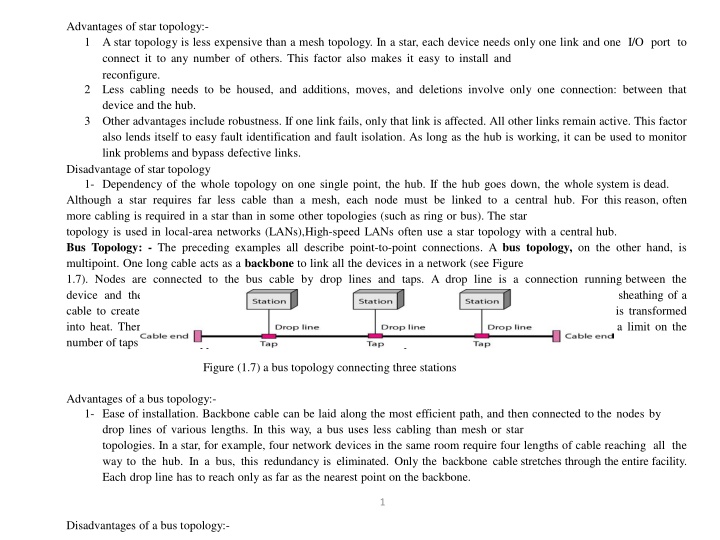
Network Topologies and Categories Overview
Explore the advantages and disadvantages of star and bus network topologies, along with insights into different network categories like LANs and WANs. Understand the benefits of star topology in terms of cost-effectiveness and robustness, while considering the drawbacks of central hub dependency. Delve into the efficiency of bus topology installation and the challenges of reconnection and fault isolation. Gain knowledge about various network sizes and types, from LANs covering small areas to WANs spanning globally.
Download Presentation

Please find below an Image/Link to download the presentation.
The content on the website is provided AS IS for your information and personal use only. It may not be sold, licensed, or shared on other websites without obtaining consent from the author. If you encounter any issues during the download, it is possible that the publisher has removed the file from their server.
You are allowed to download the files provided on this website for personal or commercial use, subject to the condition that they are used lawfully. All files are the property of their respective owners.
The content on the website is provided AS IS for your information and personal use only. It may not be sold, licensed, or shared on other websites without obtaining consent from the author.
E N D
Presentation Transcript
Advantages of star topology:- 1 A star topology is less expensive than a mesh topology. In a star, each device needs only one link and one I/O port to connect it to any number of others. This factor also makes it easy to install and reconfigure. 2 Less cabling needs to be housed, and additions, moves, and deletions involve only one connection: between that device and the hub. 3 Other advantages include robustness. If one link fails, only that link is affected. All other links remain active. This factor also lends itself to easy fault identification and fault isolation. As long as the hub is working, it can be used to monitor link problems and bypass defective links. Disadvantage of star topology 1- Dependency of the whole topology on one single point, the hub. If the hub goes down, the whole system is dead. Although a star requires far less cable than a mesh, each node must be linked to a central hub. For this reason, often more cabling is required in a star than in some other topologies (such as ring or bus). The star topology is used in local-area networks (LANs),High-speed LANs often use a star topology with a central hub. Bus Topology: - The preceding examples all describe point-to-point connections. A bus topology, on the other hand, is multipoint. One long cable acts as a backbone to link all the devices in a network (see Figure 1.7). Nodes are connected to the bus cable by drop lines and taps. A drop line is a connection running between the device and the main cable. A tap is a connector that either splices into the main cable or punctures the sheathing of a cable to create a contact with the metallic core. As a signal travels along the backbone, some of its energy is transformed into heat. Therefore, it becomes weaker and weaker as it travels farther and farther. For this reason there is a limit on the number of taps a bus can support and on the distance between those taps. Figure (1.7) a bus topology connecting three stations Advantages of a bus topology:- 1- Ease of installation. Backbone cable can be laid along the most efficient path, and then connected to the nodes by drop lines of various lengths. In this way, a bus uses less cabling than mesh or star topologies. In a star, for example, four network devices in the same room require four lengths of cable reaching all the way to the hub. In a bus, this redundancy is eliminated. Only the backbone cable stretches through the entire facility. Each drop line has to reach only as far as the nearest point on the backbone. 1 Disadvantages of a bus topology:-
Figure (1.9) a hybrid topology: a star backbone with three bus networks Categories of Networks: - The category into which a network falls is determined by its size. A LAN normally covers an area less than 2 miles; a WAN can be worldwide. Networks of a size in between are normallyreferred to as metropolitan area networks and span tens of miles. Local Area Networks (LANs) A local area network (LAN) is usually privately owned and links the devices in a singleoffice, building, or campus (see Figure 1.10). Depending on the needs of an organizationand the type of technology used, a LAN can be as simple as two PCs and a printer insomeone's home office; or it can extend throughout a company and include audio andvideo peripherals. Currently, LAN size is limited to a few kilometers. Figure (1.10)an isolated LAN connecting 12 computers to a hub in a closet 10
1 2 3 Difficult reconnection and fault isolation. A bus is usually designed to be optimally efficient at installation. Difficult to add new devices. Signal reflection at the taps can cause degradation in quality. This degradation can be controlled by limiting the number and spacing of devices connected to a given length of cable. Adding new devices may therefore require modification or replacement of the backbone. 4 In addition, a fault or break in the bus cable stops all transmission, even between devices on the same side of the problem. The damaged area reflects signals back in the direction of origin, creating noise in both directions. Bus topology was the one of the first topologies used in the design of early local area networks. Ethernet LANs can use a bus topology, but they are less popular now. Ring Topology: - In a ring topology, each device has a dedicated point-to-point connection with only the two devices on either side of it. A signal is passed along the ring in one direction, from device to device, until it reaches its destination. Each device in the ring incorporates a repeater. When a device receives a signal intended for another device, its repeater regenerates the bits and passes them along (see Figure 1.8). Figure (1.8) a ring topology connecting six stations A ring is relatively easy to install and reconfigure. Each device is linked to only its immediate neighbors (either physically or logically). To add or delete a device requires changing only two connections. The only constraints are media and traffic considerations (maximum ring length and number of devices). In addition, fault isolation is simplified. Generally in a ring, a signal is circulating at all times. If one device does not receive a signal within a specified period, it can issue an alarm. The alarm alerts the network operator to the problem and its location. However, unidirectional traffic can be a disadvantage. In a simple ring, a break in the ring (such as a disabled station) can disable the entire network. This weakness can be solved by using a dual ring or a switch capable of closing off the break. Ring topology was prevalent when IBM introduced its local-area network Token Ring. Today, the need for higher-speed LANs has made this topology less popular. 3 Hybrid Topology: - Anetwork can be hybrid. For example, we can have a main star topologywith each branch connecting several stations in a bus topology as shown in Figure 1.9.
LANs are designed to allow resources to be shared between personal computers orworkstations. The resources to be shared can include hardware (e.g., a printer), software(e.g., an application program), or data. A common example of a LAN, found in manybusiness environments, links a workgroup of task-related computers, for example, engineeringworkstations or accounting PCs. One of the computers may be given a largecapacitydisk drive and may become a server to clients. Software can be stored on thiscentral server and used as needed by the whole group. In this example, the size of theLAN may be determined by licensing restrictions on the number of users per copy of software,or by restrictions on the number of users licensed to access the operating system.In addition to size, LANs are distinguished from other types of networks by theirtransmission media and topology. In general, a given LAN will use only one type oftransmission medium. The most common LAN topologies are bus, ring, and star.Early LANs had data rates in the 4 to 16 megabits per second (Mbps) range. Today,however, speeds are normally 100 or 1000 Mbps. WideArea Networks (WANs) A wide area network (WAN) provides long-distance transmission of data, image, audio,and video information over large geographic areas that may comprise a country, a continent,or even the whole world. A WAN can be as complex as the backbones that connect the Internet or assimple as a dial-up line that connects a home computer to the Internet. We normally referto the first as a switched WAN and to the second as a point-to-point WAN (Figure 1.11). Figure (1.11) WANs: a switched WAN and a point-to-point WAN The switched WAN connects the end systems, which usually comprise a router (internetworkingconnecting device) connects to another LAN or WAN. The point-to-pointWAN is normally a line leased from a telephone or cable TV provider that connects ahome computer or a small LAN to an Internet service provider (ISP). This type of WANis often used to provide Internet access. An early example of a switched WAN is X.25, a network designed to provide connectivitybetween end users. A exampleof a switched WAN is the asynchronous transfer mode (ATM) network, which is a networkwith fixed-size data unit packets called cells. Another example ofWANs is the wireless WAN that is becoming more and more popular. that good 4
Metropolitan Area Networks (MANs) A metropolitan area network (MAN) is a network with a size between a LAN and aWAN. It normally covers the area inside a town or a city. It is designed for customerswho need a high-speed connectivity, normally to the Internet, and have endpointsspread over a city or part of city. A good example of a MAN is the part of the telephonecompany network that can provide a high-speed (Digital Subscriber Line) DSL line to the customer. Anotherexample is the cable TV network that originally was designed for cable TV, but todaycan also be used for high-speed data connection to the Internet. Interconnection of Networks: Internetwork: - Today, it is very rare to see a LAN, a MAN, or a LAN in isolation; they are connectedto one another. When two or more networks are connected, they become aninternetwork, or internet. As an example, assume that an organization has two offices, one on the east coastand the other on the west coast. The established office on the west coast has a bus topologyLAN; the newly opened office on the east coast has a star topology LAN. The president ofthe company lives somewhere in the middle and needs to have control over the company from her home. To create a backbone WAN for connecting these three entities (two LANs and the president's computer), a switched WAN operated by a service provider such as a telecom company) has been leased. To connect the LANs to this switched WAN, however, three point-to- point WANs are required. These point-to-point WANs can be a high-speed DSL line offered by a telephone company or a cable modern line offered by a cable TV provider as shown in Figure 1.12. Figure (1.12) a heterogeneous network made of four WANs and two LANs 5
THE INTERNET The Internet has revolutionized many aspects of our daily lives. It has affected the waywe do business as well as the way we spend our leisure time. Count the ways you'veused the Internet recently. Perhaps you've sent electronic mail (e-mail) to a businessassociate, paid a utility bill, read a newspaper from a distant city, or looked up a localmovie schedule-all by using the Internet. Or maybe you researched a medical topic,booked a comparison-shopped for acar. The Internet is a communication system that has brought a wealth of information toour fingertips and organized it for our use.The Internet is a structured, organized system. Brief History: -A network is a group of connected communicating devices such as computers and printers. An internet (note the lowercase letter i) is two or more networks that can communicate with each other. The most notable internet is called the Internet (uppercase letter I), a collaboration of more than hundreds of thousands of interconnected networks. Private individuals as well as various organizations such as government agencies, schools, research facilities, corporations, and libraries in more than 100 countries use the Internet. Millions of people are users. Yet this extraordinary communication system only came into being in 1969. hotel reservation, chatted with a fellow Ali, or In the mid-1960s, mainframe computers in research organizations were standalonedevices. manufacturers were unable to communicatewith one another. The Advanced Research Projects Agency (ARPA) in the Departmentof Defense (DoD) was interested in finding a way to connect computers so could share their findings, thereby reducing costs and eliminatingduplication of effort. Computers from different thatthe researchers they funded In 1967, at an Association for Computing Machinery (ACM) meeting, ARPA presentedits ideas for ARPANET, a small network of connected computers. The idea wasthat each host computer (not necessarily from the same manufacturer) would beattached to a specialized computer, called an interface message processor (IMP). TheIMPs, in turn, would be connected to one another. Each IMP had to be able to communicatewith other IMPs as well as with its own attached host. By 1969, ARPANET was a reality. Four nodes, at the University of California atLos Angeles (UCLA), the University of California at Santa Barbara (UCSB), StanfordResearch Institute (SRI), and the University of Utah, were connected via the IMPs toform a network. Software called the Network Control Protocol (NCP) provided communicationbetween the hosts. In 1972, Vint Cerf and Bob Kahn, both of whom were part of the core ARPANETgroup, collaborated on what they called the Internetting Project. Cerf and Kahn's landmark1973 paper outlined the protocols to achieve end-to-end delivery of packets. Thispaper on Transmission Control Protocol (TCP) included concepts such as encapsulation,the datagram, and the 6
Syntax: - The term syntax refers to the structure or format of the data, meaning the order in which they presented. For example, a simple protocol might expect the first 8 bits of data to be the address of the sender, the second 8 bits to be the address of the receiver, and the rest of the stream to be the message itself. Semantics: - The word semantics refers to the meaning of each section of bits. How is a particular pattern to be interpreted, and what action is to be taken based on that interpretation? For example, does an address identify the route to be taken or the final destination of the message? Timing: - The term timing refers to two characteristics: when data should be sent and how fast they can be sent. For example, if a sender produces data at 100 Mbps but the receiver can process data at only 1 Mbps, the transmission will overload thereceiver and some data will be lost. are Standard:- Standards are essential in creating and maintaining an open and competitive market for equipment manufacturers and in guaranteeing national and international technology and processes. Standards provide guidelines to manufacturers, vendors, government agencies, and other service providers to ensure the kind of interconnectivity necessary in today's marketplace and in international communications. interoperability of data and telecommunications Standards forums, and government regulatory agencies. 1 standards creation committees:- International Organization for Standardization (ISO). International Telecommunication Union-Telecommunication Standards Sector (ITU-T). American National Standards Institute (ANSI). Institute of Electrical and Electronics Engineers (IEEE). Electronic Industries Association (EIA). 2 Forums: - special-interest groups have developed forumsmade up of representatives from interested corporations. The forumswork with universities and users to test, evaluate, and standardize new technologies. 3 Regulatory Agencies: - All communications technology is subject to regulation by government agencies such as the Federal Communications Commission(FCC) in the United States. The purpose of these agencies is to protect the public interest by regulating radio, television, and wire/cable communications. Organizations: - Standards are developed through the cooperation of standards creation committees, 7





